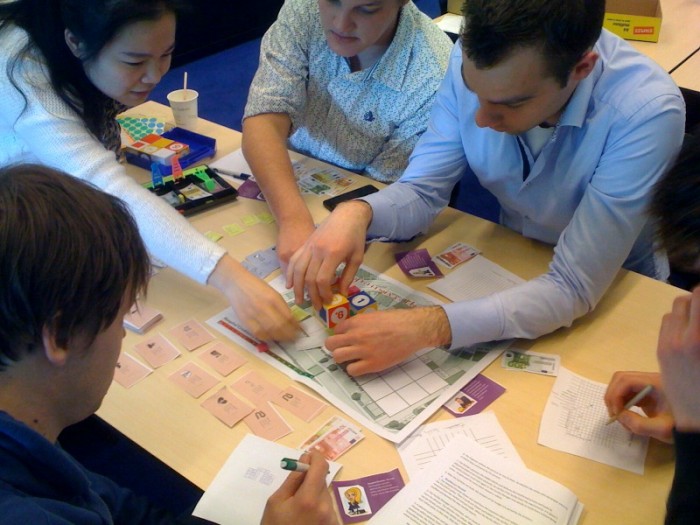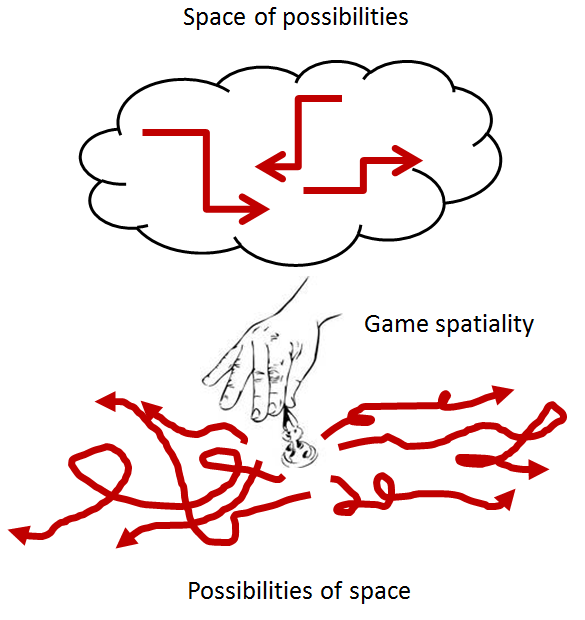I’m developing a concept to understand how board games are employed to produce a social space among the players where conflict is enacted and worked out.
Game spatiality is the sense of being in a space produced by playing a particular game. This sense is gradually developed through the bodily actions of players trying to make sense of the game mechanics, position themselves in the game, and act meaningfully. These actions involves seeing and touching the physical parts of the game — pawns, boards, cards, etc., accelerating or slowing down the rhythm of play, listening and responding to other players talk, and eventually gesticulating, standing up, bending, and coming closer to another player. Hence, the sense of being in space depends on the engagement of players with those actions; if one player is not engaged as much as the others, the sense of being in space is for everybody affected.
Whereas the sense of being in physical space is given by the proprioceptive muscular-nerve system, the sense of being in social space is much more complicated to track. As two players develop an antagonistic relationship with one another, they might not move their bodies to demarcate social distance until there is an outburst in play, for example, due to the revelation of an undercover strategy or due to one player breaking the rules.
Interesting enough, this distance is not necessarily coherent with an activity outside of play. Play activity has this attractive feature of enacting different social relationships that players are bound or accustomed to in other activities. The produced relationships are not limited to distance, though. The possibilities of space encompass coexistence, encounter, imagination, demarcation, and attachment, just to mention a few.
The possibilities of space in play activity are endless, but players do not need to be aware to produce them. Due to the recursive nature of game rhythm, every action in a game changes the possibilities for the subsequent actions. Some possibilities may be discussed among the players, some may be considered in player’s thoughts, but the vast majority will remain unexplored. Game spatiality is what mediates between the possibilities of space and the space of possibilities, the latter corresponding to the considered ones. The more immersed players are in game spatiality, the more they might bring the possibilities of space to the space of possibilities, where they are anticipated, evaluated, and strategized.
Whilst the space of possibilities is conceived in discourse and thought, the possibilities of space are lived by players’ bodily actions, a difference that implies eventual mismatches. The possibilities conceived might not be the ones lived. That is why tactics is needed to complement or counteract strategies. For example, well-conceived plan might be undermined by another player reacting quickly in unexpected or random ways. In that case, the plan must be adjusted along its execution.
On one hand, the possibilities of space are not waiting to be explored, but waiting to be created. On the other hand, the space of possibilities is already pre-defined and structured by the rules, quantifiable outcomes, and necessary choices that a game introduces in play activity. The space of possibilities is not just smaller than the possibilities of space, but also of a different quality: abstract, speculative, arbitrary.
Game spatiality lies between those two poles, actively producing and mediating their growth. Game spatiality has the potential to expand the space of possibilities when facing breakdowns in gameplay or harsh conflicts between players. In that case, the possibilities must be reconceived or renegotiated. The agreement to ignore a rule that is not working well comes from the accumulated perception of awkwardness and it opens up for new courses of action, for instance. By the same token, game spatiality can expand the possibilities of space by directly changing game conditions, such as purposefully rolling a dice out of the table to destabilize chance.
This concept is being developed to analyze how board games can be employed to explain the usage of games in service design, a research project I’m working with Julia Garde.


